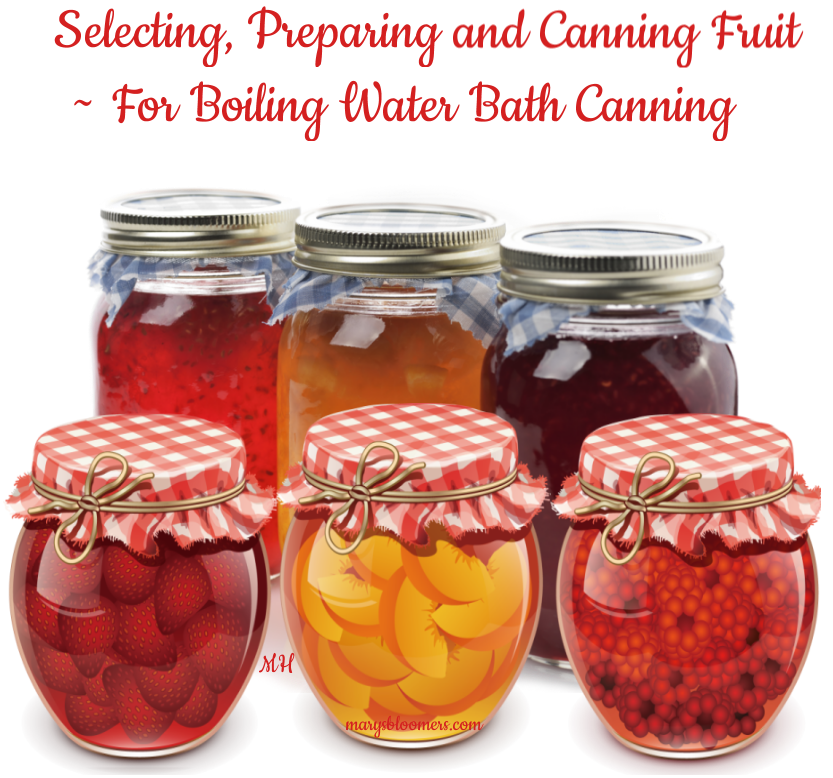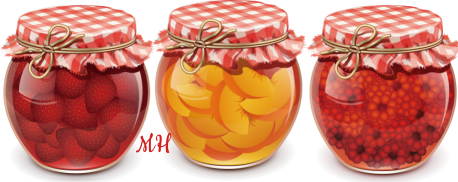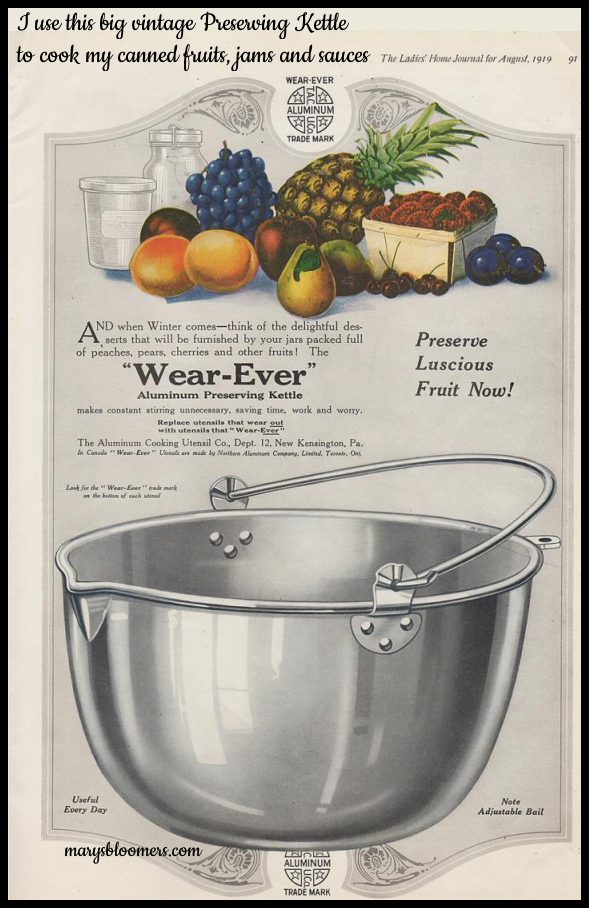 |
|
To download a .pdf of this page to save to your computer, click here Free
Vintage Gardening, Canning and Preserving Pamphlets for download---> Adding syrup to canned fruit helps to retain its flavor, color, and shape. It does not prevent spoilage of these foods. The guidelines for preparing and using syrups (Table 1) offer a new "very light" syrup, which approximates the natural sugar content of many fruits. The sugar content in each of the five syrups is increased by about 10 percent. Quantities of water and sugar to make enough syrup for a canner load of pints or quarts are provided for each syrup type. Procedure: Heat water and sugar together. Bring to a boil and pour over raw fruits in jars. For hot packs, bring water and sugar to boil, add fruit, reheat to boil, and fill into jars immediately. Other sweeteners: Light corn syrups or mild-flavored honey may be used to replace up to half the table sugar called for in syrups.
Ingredients For proper texture, jellied fruit products require the correct combination of fruit, pectin, acid, and sugar. The fruit gives each spread its unique flavor and color. It also supplies the water to dissolve the rest of the necessary ingredients and furnishes some or all of the pectin and acid. Good-quality, flavorful fruits make the best jellied products. Pectins are substances in fruits that form a gel if they are in the right combination with acid and sugar. All fruits contain some pectin. Apples, crab apples, gooseberries, and some plums and grapes usually contain enough natural pectin to form a gel. Other fruits, such as strawberries, cherries, and blueberries, contain little pectin and must be combined with other fruits high in pectin or with commercial pectin products to obtain gels. Because fully ripened fruit has less pectin, one-fourth of the fruit used in making jellies without added pectin should be underripe. Caution: Commercially frozen and canned juices may be low in natural pectins and make soft textured spreads. The proper level of acidity is critical to gel formation. If there is too little acid, the gel will never set; if there is too much acid, the gel will lose liquid (weep). For fruits low in acid, add lemon juice or other acid ingredients as directed. Commercial pectin products contain acids which help to ensure gelling. Sugar serves as a preserving agent, contributes flavor, and aids in gelling. Cane and beet sugar are the usual sources of sugar for jelly or jam. Corn syrup and honey may be used to replace part of the sugar in recipes, but too much will mask the fruit flavor and alter the gel structure. Use tested recipes for replacing sugar with honey and corn syrup. Do not try to reduce the amount of sugar in traditional recipes. Too little sugar prevents gelling and may allow yeasts and molds to grow. Jams and jellies with reduced sugar Jellies and jams that contain modified pectin, gelatin, or gums may be made with noncaloric sweeteners. Jams with less sugar than usual also may be made with concentrated fruit pulp, which contains less liquid and less sugar. Two types of modified pectin are available for home use. One gels with one-third less sugar. The other is a low-methoxyl pectin which requires a source of calcium for gelling. To prevent spoilage, jars of these products must be processed longer in a boiling-water canner. Recipes and processing times provided with each modified pectin product must be followed carefully. The proportions of acids and fruits should not be altered, as spoilage may result. Acceptably gelled refrigerator fruit spreads also may be made with gelatin and sugar substitutes. Such products spoil at room temperature, must be refrigerated, and should be eaten within 1 month. Preventing spoilage Even though sugar helps preserve jellies and jams, molds can grow on the surface of these products. Research now indicates that the mold which people usually scrape off the surface of jellies may not be as harmless as it seems. Mycotoxins have been found in some jars of jelly having surface mold growth. Mycotoxins are known to cause cancer in animals; their effects on humans are still being researched. Because of possible mold contamination, paraffin or wax seals are no longer recommended for any sweet spread, including jellies. To prevent growth of molds and loss of good flavor or color, fill products hot into sterile Mason jars, leaving 1/4-inch headspace, seal with self-sealing lids, and process 5 minutes in a boiling-water canner. Correct process time at higher elevations by adding 1 additional minute per 1,000 ft above sea level. If unsterile jars are used, the filled jars should be processed 10 minutes. Use of sterile jars is preferred, especially when fruits are low in pectin, since the added 5-minute process time may cause weak gels. Making Jam without Added PectinMy notes: I don't use commercial pectin. I use sugar or powdered konjac root (powdered glucomannan). This is a nutritional supplement used to increase fiber in your diet. But it comes powdered, and you can use it to thicken jams, sauces and gravies. It has no taste, dissolves thoroughly, and thickens quickly when whisked into your jam or saucepot.
Wash and rinse all fruits thoroughly before cooking. Do not soak. For best flavor, use fully ripe fruit. Remove stems, skins, and pits from fruit; cut into pieces and crush. For berries, remove stems and blossoms and crush. Seedy berries may be put through a sieve or food mill. Measure crushed fruit into large saucepan using the ingredient quantities specified in Table 1. Add sugar and bring to a boil while stirring rapidly and constantly. Continue to boil until mixture thickens. Use one of the following tests to determine when jams and jellies are ready to fill. Remember to allow for thickening during cooling. Temperature test: Use a jelly or candy thermometer and boil until mixture reaches the temperature for your altitude (Table 3). Refrigerator test: Remove the jam mixture from the heat. Pour a small amount of boiling jam on a cold plate and put it in the freezing compartment of a refrigerator for a few minutes. If the mixture gels, it is ready to fill. Remove from heat and skim off foam quickly. Fill sterile jars with jam. Use a measuring cup or ladle the jam through a wide-mouthed funnel, leaving 1/4-inch headspace. Adjust lids and process. Recommended process times are listed in Table 2.
Recipes
Plum Jam
|
|||||||||||||||||||||||||||||||||||||||||||||||||||||||||||||||||||||||||||||||||||||||||||||||||||||||||||||||||||||||||||||||||||||||||||||||||||||||||||||||||||||||||||||||||||||||||||||||||||||||||||||||||||||||||||||||||||||||||||||||||||||||||||||||||
|
Table 1. Recommended process time for Plum Jam in a boiling water canner. |
||||
|
|
Process Time at Altitudes of |
|||
|
Style of Pack |
Jar Size |
0 - 1,000 ft |
1,001 - 6,000 ft |
Above 6,000 ft |
|
Hot |
Half-pints |
5 min |
10 |
15 |
Fig Jam
without added pectin
I grow my own figs, and i like to preserve them for pastry fillings, syrup and spreads
-
2 quarts chopped fresh figs (about 5 pounds)
-
¾ cup water
-
6 cups sugar
-
¼ cup lemon juice
Yield: About 10 half-pint jars
Procedure:
To Prepare Chopped Figs - Pour boiling water over figs; let stand 10 minutes. Drain, stem and chop figs.
To Make Jam - Sterilize canning jars. Measure and add ¾ cup water and sugar to figs. Slowly bring to boiling, stirring occasionally until sugar dissolves. Cook rapidly until thick. Stir frequently to prevent sticking. Add lemon juice and cook 1 minute longer. Pour hot jam into hot jars, leaving ¼-inch headspace. Wipe rims of jars with a dampeneded clean paper towel; adjust two-piece metal canning lids. Process in a Boiling Water Canner.
|
Table 1. Recommended process time for Fig Jam in a boiling water canner. |
||||
|
|
Process Time at Altitudes of |
|||
| Style of Pack | Jar Size | 0 - 1,000 ft | 1,001 - 6,000 ft | Above 6,000 ft |
| Hot |
Half-pints |
5 min |
10 |
15 |
Berry Jams
without added pectin
-
9 cups crushed berries (I use a mini processor to rough chop)
-
6 cups sugar
Yield: About 7 or 8 half-pint jars
Procedure: Sterilize canning jars. Wash berries before crushing. Combine berries and sugar. Bring slowly to a boil, stirring occasionally until sugar dissolves. Once sugar is dissolved, cook rapidly to, or almost to, the jellying point, depending upon whether a firm or soft jam is desired. As mixture thickens, stir frequently to prevent sticking. Remove from heat and fill hot jam into hot, sterile jars, leaving ¼-inch headspace. Wipe rims of jars with a dampened clean paper towel; adjust two-piece metal canning lids. Process in a Boiling Water Canner.
NOTE: If seedless jam is preferred, crushed berries may be heated until soft and pressed through a sieve or food mill; then add sugar and proceed as above.
|
Table 1. Recommended process time for Berry Jams in a boiling water canner. |
||||
|
|
Process Time at Altitudes of |
|||
|
Style of Pack |
Jar Size |
0 - 1,000 ft |
1,001 - 6,000 ft |
Above 6,000 ft |
|
Hot |
Half-pints |
5 min |
10 |
15 |
Canned Lemon Curd
I LOVE citrus curd on scones or toast with Devonshire or clotted cream or marscapone.. it's also awesome between layers of any pastry or cake.
-
2½ cups superfine sugar*
-
½ cup lemon zest (freshly zested)
-
¾ cup unsalted butter, chilled, cut into approximately ¾" pieces
-
7 large egg yolks
-
4 large whole eggs
Yield: About 3 to 4 half-pint jars
Procedure:
Wash 4 half-pint canning jars with warm, soapy water. Rinse well; keep hot until ready to fill. Prepare canning lids according to manufacturer's directions.
Fill boiling water canner with enough water to cover the filled jars by 1 to 2 inches. Use a thermometer to preheat the water to 180°F by the time filled jars are ready to be added
Caution: Do not heat the water in the canner to more than 180°F before jars are added. If the water in the canner is too hot when jars are added, the process time will not be long enough. The time it takes for the canner to reach boiling after the jars are added is expected to be 25 to 30 minutes for this product. Process time starts after the water in the canner comes to a full boil over the tops of the jars.
Combine the sugar and lemon zest in a small bowl, stir to mix, and set aside about 30 minutes. Pre-measure the lemon juice and prepare the chilled butter pieces.
Heat water in the bottom pan of the double boiler until it boils gently. The water should not boil vigorously or touch the bottom of the top double boiler pan or bowl in which the curd is to be cooked. Steam produced will be sufficient for the cooking process to occur.
In the top of the double boiler, on the counter top or table, whisk the egg yolks and whole eggs together until thoroughly mixed. Slowly whisk in the sugar and zest, blending until well mixed and smooth. Blend in the lemon juice and then add the butter pieces to the mixture.
Place the top of the double boiler over boiling water in the bottom pan. Stir gently but continuously with a silicone spatula or cooking spoon, to prevent the mixture from sticking to the bottom of the pan. Continue cooking until the mixture reaches a temperature of 170°F. Use a food thermometer to monitor the temperature. Remove the double boiler pan from the stove and place on a protected surface, such as a dish cloth or towel on the counter top. Continue to stir gently until the curd thickens (about 5 minutes). Strain curd through a mesh strainer into a glass or stainless steel bowl; discard collected zest.
Fill hot strained curd into the clean, hot half-pint jars, leaving ½-inch headspace. Remove air bubbles and adjust headspace if needed. Wipe rims of jars with a dampened, clean paper towel; apply two-piece metal canning lids.
Process in the prepared boiling water canner according to the recommendations below Let cool, undisturbed, for 12 to 24 hours and check for seals.
|
|
||||
|
|
Process Time at Altitudes of |
|||
|
Style of Pack |
Jar Size |
0 - 1,000 ft |
1,001 - 6,000 ft |
Above 6,000 ft |
|
Hot |
Half-pints |
15 min |
20 |
25 |
Shelf Life: For best quality, store in a cool, dark place
(away from light). Plan to use canned lemon curd within 3 to 4 months. Browning
and/or separation may occur with longer storage; discard any time these changes
are observed.
Prepared lemon curd can also be frozen instead of canned for up to 1 year without quality changes when thawed. Package in freezer containers after straining and cooling to room temperature. To thaw, place container in a refrigerator at 40°F or lower for 24 hours before intended use. After thawing, consume within 4 weeks.
Preparation Notes:
* If superfine sugar is not available, run granulated sugar through a grinder or food processor for 1 minute, let settle, and use in place of superfine sugar. Do not use powdered sugar.
** Bottled lemon juice is used to standardize acidity. Fresh lemon juice can vary in acidity and is not recommended.
*** If a double boiler is not available, a substitute can be made with a large bowl or saucepan that can fit partway down into a saucepan of a smaller diameter. If the bottom pan has a larger diameter, the top bowl or pan should have a handle(s) that can rest on the rim of the lower pan.
Variation: For Lime Curd, use the same recipe but substitute 1 cup bottled lime juice and ¼ cup fresh lime zest for the lemon juice and zest.
Fruit Purees
Procedure: Stem, wash, drain, peel, and remove pits if necessary. Measure fruit into large saucepan, crushing slightly if desired. Add 1 cup hot water for each quart of fruit. Cook slowly until fruit is soft, stirring frequently. Press through sieve or food mill. If desired for flavor, add sugar to taste. Reheat pulp to boil, or until sugar dissolves if added. Fill hot mixture into clean jars, leaving 1/4-inch headspace. Adjust lids and process.
Processing directions for canning purees in a boiling-water canner
| Recommended process time for Fruit Purees in a boiling-water canner. | ||||
| Process Time at Altitudes of | ||||
| Style of Pack | Jar Size | 0 - 1,000 ft | 1,001 - 6,000 ft | Above 6,000 ft |
| Hot | Pints or Quarts | 15 min | 20 | 25 |

To download this page as a .pdf and save to your computer, click here
Page 2 - More recipes for preserving homegrown and foraged foods--->
Information Sources:
Adapted from USDA
the "Complete Guide to Home Canning," Agriculture Information
Bulletin No. 539
"So Easy to Preserve", 6th ed. 2014. Bulletin 989
Vintage jam recipes
Storing your autumn harvest
The Historic Victory Gardens - Canning
|
Great Big Detailed Site Directory--> Quick Links |
Design, graphics,
articles and
photos ©2022 marysbloomers.com™
All rights reserved.
